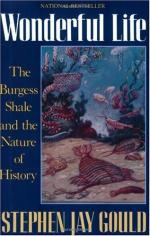|
This section contains 693 words (approx. 2 pages at 400 words per page) |

|
Chapter 1, The Iconography of an Explanation Summary and Analysis
The Burgess Shale is the largest collection of fossils ever discovered. It is composed of invertebrates, found in the Canadian Rockies, within Yoho National Park, which is close to the eastern border of British Columbia. It is perhaps the most important collection of fossils that scientists have uncovered and it offers unique insight into the nature of life and the evolution of life forms. Stephen Jay Gould proposes to use the Burgess Shale to illustrate the nature of history, not only to tell the reader the tale of human evolution but to draw some philosophical points from it. The first chapter explains the original interpretation of the development of life communicated by the Burgess Shale and the subsequent, distinct interpretation. Gould draws some deep methodological and philosophical lessons from the shift...
(read more from the Chapter 1, The Iconography of an Explanation Summary)
|
This section contains 693 words (approx. 2 pages at 400 words per page) |

|




